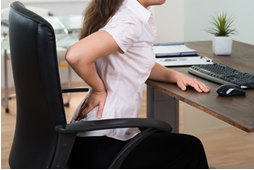Work-life balance isn’t the only thing that suffers as a result of spending longer hours in the office. Many neglect to pay attention to the needs of their bodies after remaining sedentary for extended periods of time – specifically, the health of their back. Healthcare practitioners are urging patients to learn how to properly take care of the body’s center of support. Knowing how to set up a back-friendly workstation and when to take a few breaks throughout the day won’t only lead to higher productivity, but a life free of aches and pains.

Dr. Steven Darden, who will speak at AmCham China on Aug. 21 at 3:15pm, spoke with AmCham China to give a few tips on how to lessen the impact of long hours at a desk.
It’s not the sitting per se that’s bad for you, it’s staying in a seated position for extended periods of time and assuming that posture as the years go on. We’re creatures of flexion, which means that we’re in a flexion posture because of modern life- when we’re driving, sitting, working on a computer or watching TV. We need to work getting toward a posture of extension, where your shoulders are in line with your hips, which will help recreate bodily harmony.
The best way is to first of all make sure that your works station is ergonomically correct. This means the monitor height is in the correct position, you have a good chair, and your mouse is in the proper place. There are several websites you can visit to help get an idea of what an ergonomic workstation looks like. It’s all well and good that people are going for the standing desks if you’re athletic, but ideally I think what’s important is taking a break every couple of hours and getting back into the proper posture. That means getting more in tune with your body. People tend to assume the same position for however long they’re working, and when they go back home, they’re in the mindset of being in that posture. The compensations that’ve taken place during the workday stay. Throughout the day there are some office yoga potions you can do to help combat the flexion position.
 There are some programs you can get for your computer that are reminders that let you know every couple of hours to take a quick break to stand up and stretch and check in with your body. Make sure you don’t have what I call “the weight of the world on your shoulders” that feels like its pulling you down. Getting a checkup to find out where your posture is at and chiropractic adjustments is also very beneficial. A two to five minute break every hour is great to combat the compensations your body is going through while you’re in a seated position.
There are some programs you can get for your computer that are reminders that let you know every couple of hours to take a quick break to stand up and stretch and check in with your body. Make sure you don’t have what I call “the weight of the world on your shoulders” that feels like its pulling you down. Getting a checkup to find out where your posture is at and chiropractic adjustments is also very beneficial. A two to five minute break every hour is great to combat the compensations your body is going through while you’re in a seated position.
Women with larger breasts who tend to roll their shoulders are the most at risk. Then it comes down to older individuals or people that work long hours or have been working the same job for decades. Younger people tend to be more active and in-tune with their bodies, especially athletes. They tend to know how to counteract the effects of compensation that might be occurring.
I have found that the mindset in China is similar to that of where I grew up in DC in that everyone thinks they need to work 12-15 hours a day just to get ahead. So the problems here are the same as they are in the US and offices have become more aware of their workers’ health needs.
I’m a firm believer in yoga. I’ve learned many different styles and taken teacher training and along with my treatment I show patients stretches and exercises to take home. I tend to like putting people in charge of their own health. I can only do so much, and patients need to help themselves out. By practicing yoga you’re much more conscious of your posture throughout the whole day.

